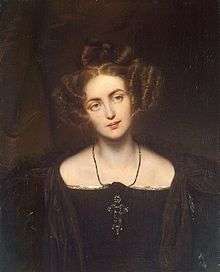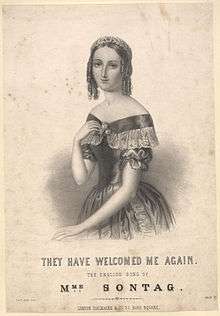Henriette Sontag
| Henriette Sontag | |
|---|---|
 Henriette Sontag as Donna Anna | |
| Born |
Gertrude Walpurgis Sontag 3 January 1806 Koblenz |
| Died | 17 June 1854 (aged 48) |
| Occupation | Opera singer (soprano) |
| Years active | 1823–1854 |
Henriette, Countess Rossi (3 January 1806 – 17 June 1854), was a German operatic soprano of great international renown. She possessed a sweet-toned, lyrical voice and was a brilliant exponent of florid singing.
Life
Sontag was born at Koblenz, Germany as Gertrude Walpurgis Sontag. She made her début at the age of 15. In 1823 she sang at Leipzig in Carl Maria von Weber's Der Freischütz and in December of that year created the title role in his Euryanthe. Her success was immediate, and in 1824 she went to the Königstädter Theater, Berlin.
She was invited to be the soprano soloist in the first performances of Beethoven's Symphony No. 9 and Missa Solemnis on 7 May 1824; she was only 18 years old at the time.
Two years later, she sang the part of Rosina in Rossini's Il barbiere di Siviglia, in which her charming personality and fleet coloratura skills granted her a distinct triumph over the reigning diva, Angelica Catalani.
In 1827, she was engaged at the Paris Italian Opera, and a year later married Count Carlo Rossi. She subsequently performed at all the major musical centres of Europe, and in 1852 visited the United States where, among other engagements, she performed in a concert with the violinist Camilla Urso.
She was hired by the Italian Opera in Mexico City, where on 17 May 1854, she intoned for the first time the words of the Mexican national anthem, written by poet Francisco González Bocanegra. One month later, she was stricken with cholera and died at the age of 48. Her last appearance, fourteen days before her death, was in the role of Desdemona of Rossini's Otello. She is buried in Germany at St. Marienthal Abbey.

The following description of her voice by Hector Berlioz was included in a Dwight's Journal of Music article:-
"She unites all the qualities—although not in an equal degree—all like to find in an artist: sweetness never surpassed, agility almost fabulous, expression, and the most perfect intonation. On she carols, higher and higher, like a lark at "heaven's gate", so soft, so clear, so wonderfully distinct that, like the silver bell from the altar, it is heard through the pealing organ. But her principal merit, in our eyes, is the absence of 'rant'—the substitute of genius—in any shape whatever. She always SINGS, and does not depend on mere strength of lungs—erroneously called 'power'. She never strains her delicate organ—that sweet instrument so susceptible of every shade of expression. How fortunate for our young singers that, like the nuns in Meyerbeer's Robert le Diable she left the tomb of the seven ancestors, bestowed by the King of Prussia upon the Countess de Rossi, to teach them the wide difference between singing and screaming, and to show how we all, during the last ten years, have been listening to, and adoring false prophets."[1]
References
- ↑ Article on Sontag, Dwight's Journal of Music, August 28, 1852, Volumes 1&2, quoting from Courrier des États-Unis. Sontag-iana
![]() The full text of University Musical Encyclopedia – Great Vocalists: "Henriette Sontag" at Wikisource
The full text of University Musical Encyclopedia – Great Vocalists: "Henriette Sontag" at Wikisource
- Guadalupe Jiménez Codinach, La guía del Himno Nacional Mexicano, Artes de México, (China, 2007), pp. 88, 90.
- W. Berger, Berühmte Frauen (Berlin, 1904)
-
 This article incorporates text from a publication now in the public domain: Wood, James, ed. (1907). "Sontag, Henrietta". The Nuttall Encyclopædia. London and New York: Frederick Warne.
This article incorporates text from a publication now in the public domain: Wood, James, ed. (1907). "Sontag, Henrietta". The Nuttall Encyclopædia. London and New York: Frederick Warne.
External links
![]() Media related to Henriette Sontag at Wikimedia Commons
Media related to Henriette Sontag at Wikimedia Commons